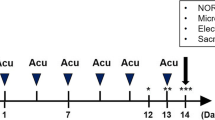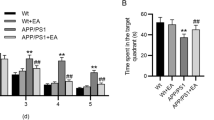Abstract
Electroacupuncture (EA) has demonstrated therapeutic potential for the treatment of Alzheimer's disease (AD). A previous study reported that N-myc downstream-regulated gene 2 (NDRG2) was upregulated in the brain of patients with AD. In the present study, we investigated the effects of repeated EA administration on reference memory impairment and the role of NDRG2 in an amyloid precursor protein (APP)/presenilin-1 (PS1) double transgenic mouse model. Age-matched wild-type and transgenic mice were treated with EA (once per day for 30 min) for 4 weeks (four courses of 5 days EA administration and 2 days rest) beginning at 10 months of age. At seven and ten postnatal months of age and following a 4-week EA treatment regime, mice received training in the Morris water maze (MWM) and a probe test. Brain tissue was analyzed via Western blot and double-label immunofluorescence. Beginning at 7 months of age, APP/PS1 mice began to exhibit deficits in reference memory in the MWM test, an impairment associated with upregulation of glial fibrillary acidic protein (GFAP) and NDRG2. Four weeks of EA administration significantly ameliorated cognitive impairments and suppressed GFAP and NDRG2 upregulation. In conclusion, our findings demonstrated that EA administration can alleviate reference memory deficits and suppress NDRG2 upregulation in an AD transgenic mouse model. This study provides supportive evidence for EA as an effective therapeutic intervention for AD, as well as NDRG2 as a novel target for AD treatment.





Similar content being viewed by others
Abbreviations
- AD:
-
Alzheimer's disease
- APP:
-
β-Amyloid precursor protein
- EA:
-
Electroacupuncture
- GFAP:
-
Glial fibrillary acidic protein
- NDRG2:
-
N-myc downstream-regulated gene 2
- LTD:
-
Long-term depression
References
Kar S, Pradhan B, Sinha RK, Kundu T, Kodgire P, Rao KK, Puranik VG, Lahiri GK (2004) Synthesis, structure, redox, NLO and DNA interaction aspects of [((L'-'")2RuII)3(mu3-L)]3+ and [(L')2RuII(NC5H4S-)] + [L3- = 1,3,5-triazine-2,4,6-trithiolato, L'-'" = arylazopyridine]. Dalton Trans 11:1752–1760. doi:10.1039/b403332a
Roberson ED, Mucke L (2006) 100 years and counting: prospects for defeating Alzheimer's disease. Science 314(5800):781–784. doi:10.1126/science.1132813
Brookmeyer R, Johnson E, Ziegler-Graham K, Arrighi HM (2007) Forecasting the global burden of Alzheimer's disease. Alzheimers Dement J Alzheimers Assoc 3(3):186–191. doi:10.1016/j.jalz.2007.04.381
Coleman LM, Fowler LL, Williams ME (1995) Use of unproven therapies by people with Alzheimer's disease. J Am Geriatr Soc 43(7):747–750
Yu J, Liu C, Zhang X, Han J (2005) Acupuncture improved cognitive impairment caused by multi-infarct dementia in rats. Physiol Behav 86(4):434–441. doi:10.1016/j.physbeh.2005.07.015
Cheng H, Yu J, Jiang Z, Zhang X, Liu C, Peng Y, Chen F, Qu Y, Jia Y, Tian Q, Xiao C, Chu Q, Nie K, Kan B, Hu X, Han J (2008) Acupuncture improves cognitive deficits and regulates the brain cell proliferation of SAMP8 mice. Neurosci Lett 432(2):111–116. doi:10.1016/j.neulet.2007.12.009
Wang Q, Wang F, Li X, Yang Q, Li X, Xu N, Huang Y, Zhang Q, Gou X, Chen S, Xiong L (2012) Electroacupuncture pretreatment attenuates cerebral ischemic injury through alpha7 nicotinic acetylcholine receptor-mediated inhibition of high-mobility group box 1 release in rats. J Neuroinflammation 9:24. doi:10.1186/1742-2094-9-24
Feng S, Wang Q, Wang H, Peng Y, Wang L, Lu Y, Shi T, Xiong L (2010) Electroacupuncture pretreatment ameliorates hypergravity-induced impairment of learning and memory and apoptosis of hippocampal neurons in rats. Neurosci Lett 478(3):150–155. doi:10.1016/j.neulet.2010.05.006
Guo Y, Shi X, Uchiyama H, Hasegawa A, Nakagawa Y, Tanaka M, Fukumoto I (2002) A study on the rehabilitation of cognitive function and short-term memory in patients with Alzheimer's disease using transcutaneous electrical nerve stimulation. Frontiers of medical and biological engineering. Int J Jpn Soc Med Electron Biol Eng 11(4):237–247
Zhou Y, Jin J (2008) Effect of acupuncture given at the HT 7, ST 36, ST 40 and KI 3 acupoints on various parts of the brains of Alzheimer's disease patients. Acupunct Electrother Res 33(1–2):9–17
Haydon PG (2000) Neuroglial networks: neurons and glia talk to each other. Curr Biol 10(19):R712–R714
Saura J, Luque JM, Cesura AM, Da Prada M, Chan-Palay V, Huber G, Loffler J, Richards JG (1994) Increased monoamine oxidase B activity in plaque-associated astrocytes of Alzheimer brains revealed by quantitative enzyme radioautography. Neuroscience 62(1):15–30
Shen L, Zhao ZY, Wang YZ, Ji SP, Liu XP, Liu XW, Che HL, Lin W, Li X, Zhang J, Yao LB (2008) Immunohistochemical detection of Ndrg2 in the mouse nervous system. Neuroreport 19(9):927–931. doi:10.1097/WNR.0b013e32830163d0
Li Y, Shen L, Cai L, Wang Q, Hou W, Wang F, Zeng Y, Zhao G, Yao L, Xiong L (2011) Spatial-temporal expression of NDRG2 in rat brain after focal cerebral ischemia and reperfusion. Brain Res 1382:252–258. doi:10.1016/j.brainres.2011.01.023
Zuo ZF, Wang W, Niu L, Kou ZZ, Zhu C, Wang W, Zhao XH, Luo DS, Zhang T, Zhang FX, Liu XZ, Wu SX, Li YQ (2011) RU486 (mifepristone) ameliorates cognitive dysfunction and reverses the down-regulation of astrocytic N-myc downstream-regulated gene 2 in streptozotocin-induced type-1 diabetic rats. Neuroscience 190:156–165. doi:10.1016/j.neuroscience.2011.06.025
Mitchelmore C, Buchmann-Moller S, Rask L, West MJ, Troncoso JC, Jensen NA (2004) NDRG2: a novel Alzheimer's disease associated protein. Neurobiol Dis 16(1):48–58. doi:10.1016/j.nbd.2004.01.003
Pistell PJ, Zhu M, Ingram DK (2008) Acquisition of conditioned taste aversion is impaired in the amyloid precursor protein/presenilin 1 mouse model of Alzheimer's disease. Neuroscience 152(3):594–600. doi:10.1016/j.neuroscience.2008.01.025
Yu Y, He J, Zhang Y, Luo H, Zhu S, Yang Y, Zhao T, Wu J, Huang Y, Kong J, Tan Q, Li XM (2009) Increased hippocampal neurogenesis in the progressive stage of Alzheimer's disease phenotype in an APP/PS1 double transgenic mouse model. Hippocampus 19(12):1247–1253. doi:10.1002/hipo.20587
Wang F, Gao Z, Li X, Li Y, Li X, Zhong H, Xu N, Cao F, Wang Q, Xiong L (2013) NDRG2 is involved in anti-apoptosis induced by electroacupuncture pretreatment after focal cerebral ischemia in rats. Neurol Res 35(4):406–414. doi:10.1179/1743132813Y.0000000159
Janus C (2004) Search strategies used by APP transgenic mice during navigation in the Morris water maze. Learn Mem 11(3):337–346. doi:10.1101/lm.70104
Blasko I, Grubeck-Loebenstein B (2003) Role of the immune system in the pathogenesis, prevention and treatment of Alzheimer's disease. Drugs Aging 20(2):101–113
Prasad KN, Cole WC, Prasad KC (2002) Risk factors for Alzheimer's disease: role of multiple antioxidants, non-steroidal anti-inflammatory and cholinergic agents alone or in combination in prevention and treatment. J Am Coll Nutr 21(6):506–522
Sastre M, Dewachter I, Rossner S, Bogdanovic N, Rosen E, Borghgraef P, Evert BO, Dumitrescu-Ozimek L, Thal DR, Landreth G, Walter J, Klockgether T, van Leuven F, Heneka MT (2006) Nonsteroidal anti-inflammatory drugs repress beta-secretase gene promoter activity by the activation of PPARgamma. Proc Natl Acad Sci U S A 103(2):443–448. doi:10.1073/pnas.0503839103
Lee H, Park HJ, Park J, Kim MJ, Hong M, Yang J, Choi S, Lee H (2007) Acupuncture application for neurological disorders. Neurol Res 29(Suppl 1):S49–S54. doi:10.1179/016164107X172211
Han J, Kesner P, Metna-Laurent M, Duan T, Xu L, Georges F, Koehl M, Abrous DN, Mendizabal-Zubiaga J, Grandes P, Liu Q, Bai G, Wang W, Xiong L, Ren W, Marsicano G, Zhang X (2012) Acute cannabinoids impair working memory through astroglial CB1 receptor modulation of hippocampal LTD. Cell 148(5):1039–1050. doi:10.1016/j.cell.2012.01.037
Wang Q, Peng Y, Chen S, Gou X, Hu B, Du J, Lu Y, Xiong L (2009) Pretreatment with electroacupuncture induces rapid tolerance to focal cerebral ischemia through regulation of endocannabinoid system. Stroke 40(6):2157–2164. doi:10.1161/STROKEAHA.108.541490
Slezak M, Pfrieger FW (2003) New roles for astrocytes: regulation of CNS synaptogenesis. Trends Neurosci 26(10):531–535. doi:10.1016/j.tins.2003.08.005
Ben Achour S, Pascual O (2010) Glia: the many ways to modulate synaptic plasticity. Neurochem Int 57(4):440–445. doi:10.1016/j.neuint.2010.02.013
Zhu D, Hu C, Sheng W, Tan KS, Haidekker MA, Sun AY, Sun GY, Lee JC (2009) NAD(P)H oxidase-mediated reactive oxygen species production alters astrocyte membrane molecular order via phospholipase A2. Biochem J 421(2):201–210. doi:10.1042/BJ20090356
Yang L, Li F, Zhang H, Ge W, Mi C, Sun R, Liu C (2009) Astrocyte activation and memory impairment in the repetitive febrile seizures model. Epilepsy Res 86(2–3):209–220. doi:10.1016/j.eplepsyres.2009.07.001
Rodriguez JJ, Olabarria M, Chvatal A, Verkhratsky A (2009) Astroglia in dementia and Alzheimer's disease. Cell Death Differ 16(3):378–385. doi:10.1038/cdd.2008.172
Acknowledgments
This work was supported by research grants from the National Natural Science Foundation of China (No. 81102631, 81000813), the Changjiang Scholar and Innovative Research Team in University (Grant 2010 CXTD01),and the Major Program of National Natural Science Foundation of China (No. 30930091).
Author information
Authors and Affiliations
Corresponding authors
Additional information
Feng Wang and Haixing Zhong contributed equally to this work.
Rights and permissions
About this article
Cite this article
Wang, F., Zhong, H., Li, X. et al. Electroacupuncture Attenuates Reference Memory Impairment Associated with Astrocytic NDRG2 Suppression in APP/PS1 Transgenic Mice. Mol Neurobiol 50, 305–313 (2014). https://doi.org/10.1007/s12035-013-8609-1
Received:
Accepted:
Published:
Issue Date:
DOI: https://doi.org/10.1007/s12035-013-8609-1




